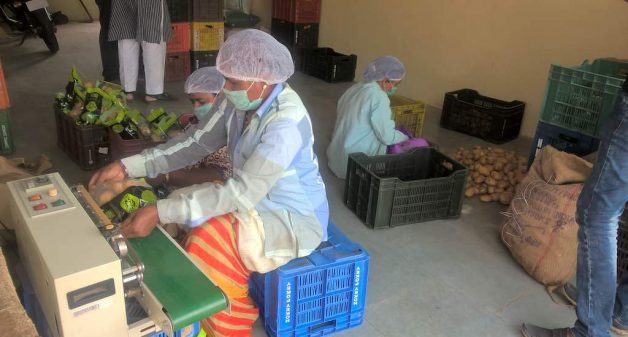A prominent non-profit in central India that works extensively and successfully on water harvesting structures has all about agrarian crisis and farmers’ portraits in their website, but almost nothing about water or rainwater harvesting. An enterprise that sells processed food talks about small farmers but hardly have any direct transaction with cultivators.
Farmers, especially small and marginal farmers, seem to have become an icon to be used by politicians, bureaucrats, media, corporate houses, and development professionals and academicians to endear themselves to the masses. In recent years, the number of events, awards and conferences on entrepreneurship, especially social entrepreneurship, has been on a surge.
While there cannot be an easy agreement across stakeholders on the definition of a social enterprise, it has become a misnomer, where any and every company working in the farm sector wishes to be called a social enterprise. In a way, the market that had once created and probably still continues to create a deficit of profit for farmers appropriates the same deficit but wears a social hat.
Farming and IT solutions
In the past decade, there has been a surge of information technology (IT) and data based company start-ups. These companies intend to serve farming and farming community by collecting information from farmers and providing customized services that aid in increasing farm productivity and income.
Often these enterprises are found to design an app, which is a platform accessed through smartphones. The app provides a range of services like weather forecasts, market prices, identifying customers, etc., to the user, using various sources of information.
While the model seems to be a perfect solution for a variety of problems that hamstring farmers, a recent study across several states shows that only about 10% of the rural population use smartphones. A negligible proportion has used it for purposes other than entertainment and accessing social media. While there have been a few scattered and limited reports of benefits of these technology-based solutions, enterprises often report several thousands of beneficiaries and multifold benefits.
Game of acquisition
We visited an IT enterprise with such a portfolio and numerous awards across global ecosystems to understand their model and operations. The CEO of the enterprise was confident that his company will acquire more than a million farmers by 2020.
Initially, it was difficult to comprehend when the CEO talked about acquiring farmers. But, as we got to know more about their operations, he candidly conveyed that they could consider selling their data on farmers for the benefit of farmers. Similar models and opinions echoed on stage at a recent social entrepreneurship conference organized by a top business incubation agency of the country.
Farming and data market
Most of us have compromised on our privacy to big tech giants like Google, Facebook etc. that use our online activity for their targeted marketing using data analytics. Similarly, there is a looming strategy for agro-chemical companies to reach their target farmers using their historical information collected and stored. Although several questions can be raised around such an exercise, it may not be easy to ignore the cost and challenges involved, value created and market price for the same.
Data collection and record keeping, especially at farm level, are resource-consuming tasks with a multitude of challenges like size of landholdings, diversity, access to farmers, scale and capacity. Collection of quantitative data from farmers involves nudging, and the numbers they give are often momentary.

Unless there is a well-established and close rapport between the farmers and the surveying entity, farmers often see the surveys as futile exercises. However, a reliable data on farm and market operations of the farmers with reasonable accuracy is of great value to various stakeholders across the farm supply chain for the future market.
Data-driven efficiency
As the global market moves towards data-driven efficiency, Indian farm sector needs to leap from an unorganized and often undocumented value chain into an inclusive and efficient market. Precision farming, and discourse on exploiting technology and data analytics are getting mainstream in developed nations, to feed the increasing global population as well as to increase farm productivity.
This will further shrink the space of small farmers in developing nations, forcing them to compete with data-driven and sophisticated agri-business companies of the West. With increasing pressure in various forms, marginal farmers of the country may not be left with much choice but to make the impending technological lunge.
The market price for farm data extends both in agri-input and commodity supply market. Indian agri-input market is one of the biggest in the world, worth over Rs 2,000 billion. With about 1/3 of the total 125 million farmers owning almost 80% of the land, about Rs 1,600 billion worth of market can be channelized through about 40 million farmers with an average sales value of Rs 40,000 per farmer.
Similarly, the net value of crop produced from these farmers will be worth more than a Rs Rs 10,000 billion annually. This certainly gives enough scope for the enterprises to ‘acquire’ farmers, collect data and record their cropping pattern and rotation, input usage, marketing cycle etc., to be used for future marketing and sales.
Value chain enterprises
While there is a rise in IT-based agri-startups that can potentially evolve and provide the support required for Indian farmers and consumers, there is an imminent need to invigorate the physical base of farming sector including production capacities, supply chain efficiency, value addition, etc. It is essential to organize, plan and synergize agricultural production, soil and water resource management, market demand and consumption.
There have been a few small but successful initiatives like Go4Fresh, Mumbai, Sahaja Aharam, Hyderabad and Organic Farmers Association, Chennai, where farmer collectives, supply chain enterprises and consumers work in coordination for a win-win situation. These enterprises aggregate the demand from consumers over various seasons and guide the farmers to plan their crop pattern to match consumer needs in time.
The key intervention of these value chain enterprises is upgrading the unorganized commodity supply chain into an organized, coordinated and documented value chain. Though the commodities and scale of operation varies, these enterprises were found to create great value and security for farmers.
While technology enterprises play an advisory and supportive role, value chain enterprises play collaborative and partnership role, facilitating transactions and business. The value chain enterprises are also found to collaborate with technology enterprises to exploit their potential.
For example, the value chain enterprise Go4Fresh avails the service of SourceTrace, a technology enterprise, to set a system where each commodity procured is geo-tagged to enable the consumer in locating the area of production, name of the producer and date of harvest.
This system helps in building trust for the consumers and increases the presence of farmers in the overall value chain. In another example, over 30 producer companies across various states provide several farm and marketing services to their member farmers by collaborating with a technology enterprise called EkGaon Technologies.
The supportive role of technology enterprises helps the value chain initiatives to leverage upon the technological innovations to strengthen and scale up their impacts. Thus, the value chain enterprises can be considered as ground agents and technology enterprises as the means to scale and efficiency.
Value share of farmers
The debate on data and privacy might continue, but organizing the supply chain and production requires documentation and record keeping. Inefficiency in supply chain and large intermediaries are often cited as the reasons for poor price realization of the farmers.
Collaborative and collective operation of farmer producer companies, supply chain enterprises and technology enterprises hold a huge potential to remove inefficiencies and increase the value share of the farmers in the farm-to-fork value chain. As quoted by vision statements of a few of these enterprises, warranting at least 60% of the final consumer price to the farmer will be a bottle-neck indicator of the impact created by technological interventions as well as role played by social enterprises.
Siva Muthuprakash is a researcher at VikasAnvesh Foundation. Views are personal.


